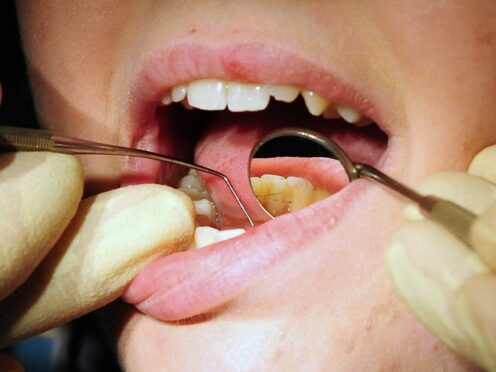
Thousands of children were admitted to hospital with tooth decay last year amid a surge in extractions.
New figures from the Office for Health Improvement and Disparities (OHID) show there were 47,581 tooth extractions in NHS hospitals in England for patients aged 0 to 19.
Some 66% of extractions – or 31,165 – were down to a primary diagnosis of tooth decay, up 17% from the previous 12 months.
The figure is the equivalent of 236 per 100,000 people in the age group.
OHID said this “is likely to reflect a continuing recovery of hospital services following the Covid-19 pandemic”.
Hospital admissions for childhood tooth extractions cost NHS hospitals £64.3 million last year, with decay-related extractions costing £40.7 million.
Tooth decay remains the most common reason for youngsters aged five to nine being admitted to hospital.
The data also showed regional disparities in decay-related extractions, with Yorkshire and the Humber reporting 405 cases per 100,000 children – the highest figure – and the East Midlands 80 per 100,000 – the lowest.
David Fothergill, chairman of the Local Government Association’s Community Wellbeing Board, said: “These stark figures reveal that a lack of access to affordable dentistry is having a worrying impact on the state of children’s teeth.
“The fact that, due to the severity of the decay, on average 119 operations are taking place each day to remove decaying teeth in children and teenagers is concerning and also adds to current pressures on our health service.
“Untreated dental care remains one of the most prevalent diseases affecting children and young people’s ability to speak, eat, play and socialise.”
🦷 Our new dentistry reform plan will make it quicker and easier to get NHS dental treatment.
Backed by £200 million over the next year, it includes extra appointments, dental vans and measures to improve oral health.
More detail 👇 https://t.co/PFbKKDePUJ pic.twitter.com/kgGdy0h8Rr
— Department of Health and Social Care (@DHSCgovuk) February 8, 2024
Publication of the data comes after the Government unveiled its £200 million plan to bolster NHS dentistry in England.
The proposals include £20,000 bonuses for dentists working in under-served communities in a bid to increase appointment capacity by 2.5 million next year.
Mobile dental teams will also be deployed to schools in under-served areas to give 165,000 children preventative fluoride varnish treatments to strengthen their teeth and prevent decay.
However, Eddie Crouch, chairman of the British Dental Association (BDA), warned “the oral health gap is widening for our youngest patients, and it won’t be halted by holding another consultation”.
“Ministers are trying to turn supervised brushing into a political football,” he said. “They need to grow up, and double down on tried and tested programmes.
“That means real commitment and ambition, comprehensively funded. So, the precise opposite of the plans we’ve seen this week.”
“It’s a sticking plaster on a gaping wound,” says BDA Chair @EddieCrouch
The Government’s so-called ‘recovery plan’ offers little hope to the millions struggling to access NHS dental care.
Sign our petition to Rishi Sunak.👇https://t.co/2FfPt0VagG pic.twitter.com/xdOm3zfdI8
— BDA (@TheBDA) February 8, 2024
In Bristol earlier this week, hundreds of people queued outside a dental practice after it opened its books for NHS patients.
Speaking in the House of Commons on Wednesday, Health Secretary Victoria Atkins said: “We know that too many, particularly those living in rural or coastal communities, are still struggling to find appointments”.
She added: “This recovery plan will put this right by making NHS dental care faster, simpler and fairer for patients and staff.”
However, Ms Atkins declined to say whether the dentistry plan is being funded by an underspend in the NHS dentistry budget.
Prime Minister Rishi Sunak described the package as a “very significant new investment”.
He told broadcasters on Thursday it will “make a significant difference, and quickly”.

Other measures included in the recovery plan include dentists being paid more for NHS work, a “Smile for Life” advice programme aimed at new parents, and the rollout of so-called “dental vans” in rural and coastal communities.
Officials also revealed more details about the biggest expansion of water fluoridation in England since the 1980s which will aim to reduce the number of tooth extractions due to decay, particularly in deprived areas.
Subject to consultation, the programme will first expand across the North East – Northumberland, County Durham, Sunderland, South Tyneside and Teesside, including Redcar and Cleveland, Stockton-on-Tees, Darlington and Middlesbrough.
This would lead to an additional 1.6 million people having fluoride – a naturally occurring mineral found in water and some foods – added to their water.
The amount of naturally occurring fluoride in water varies across the country and, in the early 20th century, researchers found that people had less tooth decay in areas with higher fluoride levels in the drinking water.
UK schemes involving adding fluoride to water date back to the 1960s, starting in the Midlands.
Around 10% of people in England currently have fluoride added to their drinking water – mostly in the West Midlands and the North East, including Newcastle and Gateshead.
The NHS Dental Recovery Plan states: “Our long-term ambition is to systematically bring fluoridation to more of the country, with a particular focus on the most deprived areas, which stand to benefit most from fluoridation.”
England’s interim chief dental officer, Jason Wong, wrote in the foreword of the document: “The consultation on expanding water fluoridation in some parts of England is an opportunity to improve the oral health of communities for generations to come.”

Enjoy the convenience of having The Sunday Post delivered as a digital ePaper straight to your smartphone, tablet or computer.
Subscribe for only £5.49 a month and enjoy all the benefits of the printed paper as a digital replica.
Subscribe